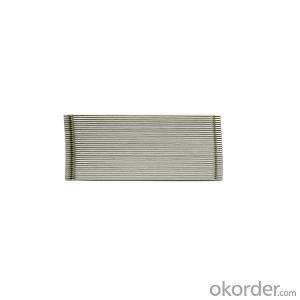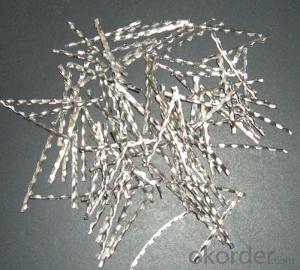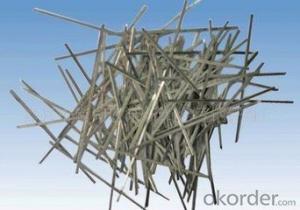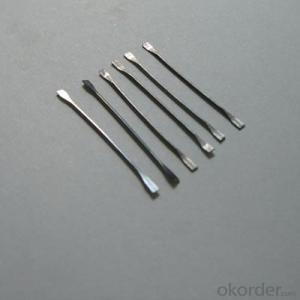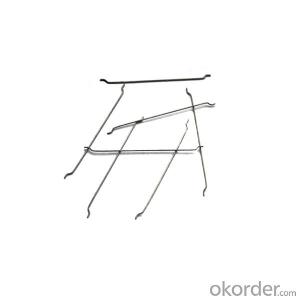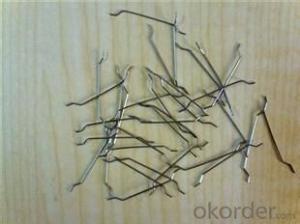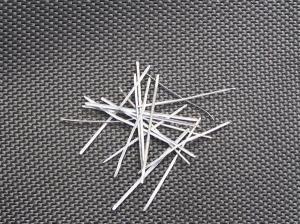Glued Steel Fiber From Company CNBM China
- Loading Port:
- Tianjin
- Payment Terms:
- TT OR LC
- Min Order Qty:
- 1 m.t.
- Supply Capability:
- 5000 m.t./month
OKorder Service Pledge
Quality Product, Order Online Tracking, Timely Delivery
OKorder Financial Service
Credit Rating, Credit Services, Credit Purchasing
You Might Also Like
Quick Details
Place of Origin: Tianjin, China (Mainland)
- Model Number: 0.9
Material: Steel
Production Process: Cold drawn
Lengh: 60
Type: 1
Compressive Strength: >1200MPa
Aspect ratio: 66
Standard: ASTM A820M-11
Section Shape: Circular
Application: Concrete Reinforcement
Packaging & Delivery
| Packaging Details: | 20 kg/Bag,50 bags/Pallet or 1,000kg/ Bulk Bag |
|---|---|
| Delivery Detail: | 1 Month |
Product Description
| Diameter | 0.75 mm | ||
| Length | 60 mm | ||
| Aspect Ratio | 80 | ||
| Tensile strength | 1200 MPa | ||
| Type | Cold drawn Steel Fiber | ||
| End | Hooked-end Steel Fiber | ||
| Glued/Loose | Glued Steel Fiber | ||
| Bending Angle | 45°(min.30°) | ||
| Usage & Performance | Floor:Trafficked areas and Industrial floors | ||
| Shotcrete :Slope stabilization and Final lining | |||
| Precast concrete:Pipe and Railway sleepers | |||
| Packing | Standard Export Pallet Packing | Bag Packing | 20 kg/Bag,50 bags/Pallet |
| Bulk Packing | 1,000kg/ Bulk Bag | ||
| Loading Quantity | 20’GP | 20-25 Tonne/Tonnes | |
| 40’GP | 25-27 Tonne/Tonnes | ||
| 40’HQ | 25-27 Tonne/Tonnes | ||
| MOQ | 1 kg for trial order | ||
| Supply Ability | 10,000 Tonne/Tonnes per Year | ||
| Payment Terms | T/T or L/C at sight | ||
| Delivery Time | Within 15 days after receiving deposit or original L/C at sight | ||
| Certification | ISO9001:2000, CE, | ||
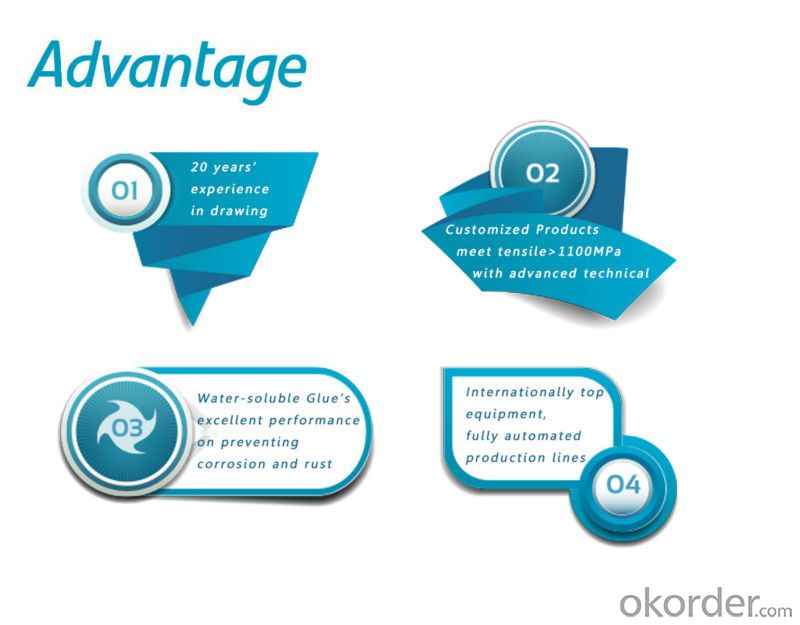
| Product | Diameter (mm) | Length (mm) | Aspect Ratio | Type | Packing |
| G-6030 | 0.5 | 30 | 60 | Glued | 20 kg/Bag, or 1,000kg/ Bulk Bag |
| G-6535 | 0.55 | 35 | 65 | Glued | 20 kg/Bag, or 1,000kg/ Bulk Bag |
| G-6035 | 0.6 | 35 | 60 | Glued | 20 kg/Bag, or 1,000kg/ Bulk Bag |
| G-8060 | 0.75 | 60 | 80 | Glued | 20 kg/Bag, 50 bags/Pallet |
| G-6060 | 0.9 | 60 | 60 | Glued | 20 kg/Bag, 50 bags/Pallet |
| G-6030 | 0.5 | 30 | 60 | Loose | 20 kg/Bag, or 1,000kg/ Bulk Bag |
| G-6535 | 0.55 | 35 | 65 | Loose | 20 kg/Bag, or 1,000kg/ Bulk Bag |
| G-6035 | 0.6 | 35 | 60 | Loose | 20 kg/Bag, or 1,000kg/ Bulk Bag |
| G-8060 | 0.75 | 60 | 80 | Loose | 20 kg/Bag, 50 bags/Pallet |
| G-6060 | 0.9 | 60 | 60 | Loose | 20 kg/Bag, 50 bags/Pallet |
- Q:What is the effect of melt extract stainless steel fiber on the modulus of rupture of shotcrete?
- The effect of melt extract stainless steel fiber on the modulus of rupture of shotcrete is that it enhances the overall strength and durability of the shotcrete. The stainless steel fibers reinforce the shotcrete matrix, preventing cracks and improving the resistance to bending and flexural stresses. This leads to an increased modulus of rupture, making the shotcrete more resistant to cracking and improving its structural performance.
- Q:How does melt extract stainless steel fiber enhance the durability of concrete structures?
- Melt extract stainless steel fiber plays a crucial role in enhancing the durability of concrete structures. These fibers, when added to the concrete mix, provide several benefits that contribute to the overall longevity and strength of the structure. Firstly, the addition of melt extract stainless steel fibers improves the resistance to cracking in concrete. The fibers act as reinforcement, distributing stress and reducing the formation of shrinkage cracks. This is particularly important in environments where concrete structures are subject to extreme temperature variations or heavy loads, as it helps to prevent the development of cracks that could compromise the integrity of the structure. Moreover, the stainless steel fibers enhance the toughness and impact resistance of concrete. By dispersing throughout the concrete matrix, they create a three-dimensional reinforcement network that improves the material's ability to absorb and distribute energy upon impact. This increased toughness prevents the propagation of cracks, making the structure more durable and resistant to damage from external forces. Another key advantage of melt extract stainless steel fibers is their ability to enhance the resistance to corrosion in concrete structures. Stainless steel is inherently resistant to rust and oxidation, even in harsh environments. By incorporating these fibers into the concrete mix, they provide an additional layer of protection against corrosion, prolonging the lifespan of the structure and reducing the need for maintenance and repair. In addition, the use of melt extract stainless steel fibers can improve the fire resistance of concrete structures. Stainless steel has a high melting point, and when added to concrete, it helps to delay the onset of structural failure under high temperatures. This is particularly important in buildings and structures where fire safety is a critical concern. Overall, the incorporation of melt extract stainless steel fibers in concrete significantly enhances the durability of structures. By improving resistance to cracking, increasing toughness and impact resistance, enhancing corrosion resistance, and improving fire resistance, these fibers ensure that the concrete structure remains strong and intact for an extended period, reducing the need for repairs and replacements, and ultimately saving costs.
- Q:What is the optimal dosage of melt extract stainless steel fiber in concrete mixes?
- The concrete mix's ideal dosage of melt extract stainless steel fiber can vary depending on various factors, including specific application requirements, desired performance characteristics, and the type of concrete used. Typically, the volume dosage of stainless steel fiber in concrete ranges from 0.5% to 2%. However, it is crucial to perform extensive testing and seek advice from industry professionals to determine the precise dosage required for each project. Using higher dosages of stainless steel fiber can enhance the concrete's mechanical properties, such as flexural strength, toughness, and impact resistance. This is particularly advantageous for applications that demand exceptional durability, such as industrial floors, precast elements, or structures exposed to heavy loads or extreme weather conditions. On the contrary, lower dosages may be suitable for applications that prioritize cost-efficiency or where the concrete's appearance plays a significant role. It is vital to strike a balance between desired performance and project economics. Furthermore, selecting the appropriate length and aspect ratio of stainless steel fibers is crucial for achieving the desired performance. Longer fibers provide better crack control and improved ductility, while shorter fibers may be more effective in reducing shrinkage cracking. To determine the optimal dosage, it is recommended to conduct trial mixes using different fiber dosages and evaluate their performance through tests such as flexural strength, impact resistance, and shrinkage tests. This will help identify the dosage that meets the specific project requirements while considering factors like workability and cost-effectiveness. In conclusion, determining the optimal dosage of melt extract stainless steel fiber in concrete mixes requires a comprehensive evaluation of project requirements, desired performance characteristics, and thorough testing. Seeking guidance from industry experts and conducting extensive trials will ensure the best outcome for each application.
- Q:Can melt extract stainless steel fiber be used in high-rise building cladding?
- Yes, melt extract stainless steel fiber can be used in high-rise building cladding.
- Q:Can melt extract stainless steel fiber be used in precast bridge elements?
- Precast bridge elements can benefit from the utilization of melt extract stainless steel fibers. These fibers, renowned for their exceptional tensile strength, resistance to corrosion, and long-lasting nature, are well-suited for a variety of construction applications, including precast bridge elements. By incorporating these fibers into concrete, its mechanical properties like flexural strength and crack resistance can be significantly improved, thus enhancing the performance and lifespan of the bridge elements. Moreover, the implementation of stainless steel fibers can reduce the necessity for conventional reinforcement, resulting in cost-effective measures and expedited construction processes. Nevertheless, it is crucial to ensure that the proper dosage and distribution of fibers are meticulously controlled during the precast fabrication procedure to achieve optimal performance and structural integrity.
- Q:What is the effect of melt extract stainless steel fiber on the permeability of asphalt mixtures?
- Melt extract stainless steel fiber has a positive effect on the permeability of asphalt mixtures. It helps to enhance the compactness and durability of the mixture, reducing the possibility of water infiltration and improving the overall performance of the asphalt pavement. The fiber acts as a reinforcement, reducing cracking and increasing the resistance to rutting and fatigue. Additionally, the stainless steel fiber can help stabilize the asphalt mixture, increasing its resistance to deformation and improving its long-term durability.
- Q:How does the addition of melt extract stainless steel fiber affect the fresh concrete properties?
- The addition of melt extract stainless steel fiber to fresh concrete can significantly enhance its properties. It improves the concrete's toughness, durability, and resistance against cracking, impact, and abrasion. The fibers act as reinforcement, dispersing stress throughout the concrete matrix, resulting in improved structural performance. Additionally, the stainless steel fibers can also improve the concrete's resistance to corrosion, making it suitable for various applications in harsh environments.
- Q:Can melt extract stainless steel fiber be used in tunnel segmental lining rehabilitation?
- Yes, melt extract stainless steel fiber can be used in tunnel segmental lining rehabilitation. It is commonly used as a reinforcement material in concrete to improve its strength, durability, and resistance to cracking. In tunnel segmental lining rehabilitation, where concrete structures need to withstand high loads and potential damage, the use of stainless steel fiber can provide significant benefits in terms of structural integrity and longevity.
- Q:Can melt extract stainless steel fiber be used in fiber-reinforced shotcrete?
- Yes, melt extract stainless steel fiber can be used in fiber-reinforced shotcrete.
- Q:Can melt extract stainless steel fiber be added to cementitious grouts?
- It is possible to incorporate melt extract stainless steel fiber into cementitious grouts. These fibers are often utilized as a reinforcement material in cementitious products to boost their mechanical properties. By introducing stainless steel fibers into grouts, one can enhance their tensile strength, flexural strength, and resistance to cracks. Furthermore, the inclusion of stainless steel fibers aids in managing shrinkage and preventing cracking. All in all, the integration of melt extract stainless steel fibers into cementitious grouts can elevate their effectiveness and longevity.
1. Manufacturer Overview |
|
|---|---|
| Location | |
| Year Established | |
| Annual Output Value | |
| Main Markets | |
| Company Certifications | |
2. Manufacturer Certificates |
|
|---|---|
| a) Certification Name | |
| Range | |
| Reference | |
| Validity Period | |
3. Manufacturer Capability |
|
|---|---|
| a)Trade Capacity | |
| Nearest Port | |
| Export Percentage | |
| No.of Employees in Trade Department | |
| Language Spoken: | |
| b)Factory Information | |
| Factory Size: | |
| No. of Production Lines | |
| Contract Manufacturing | |
| Product Price Range | |
Send your message to us
Glued Steel Fiber From Company CNBM China
- Loading Port:
- Tianjin
- Payment Terms:
- TT OR LC
- Min Order Qty:
- 1 m.t.
- Supply Capability:
- 5000 m.t./month
OKorder Service Pledge
Quality Product, Order Online Tracking, Timely Delivery
OKorder Financial Service
Credit Rating, Credit Services, Credit Purchasing
Similar products
New products
Hot products
Hot Searches
Related keywords

